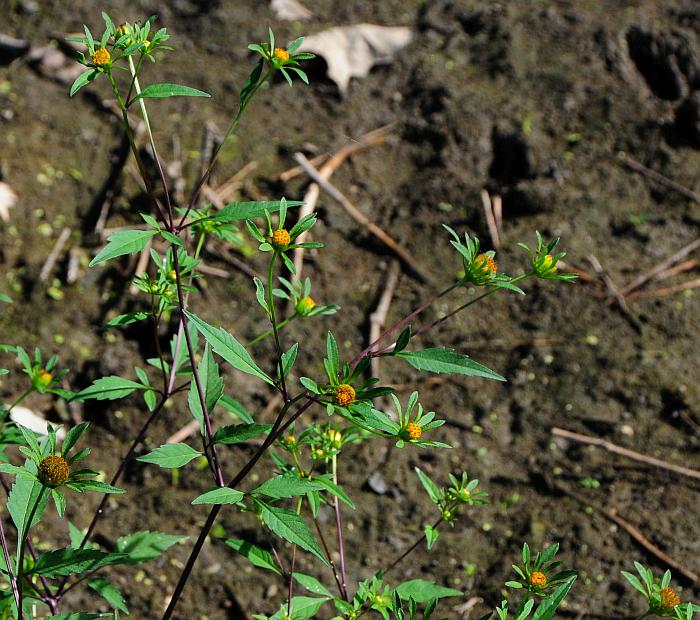Bidens frondosa L.
Beggar Ticks

Native
CC = 2
CW = -3
MOC = 64
© SRTurner
Bidens frondosa L.Beggar Ticks | |
 |
Native CC = 2 CW = -3 MOC = 64 |
© SRTurner |
|
Family - Asteraceae/Heliantheae Habit - Annual forb, usually taprooted. Stems - Ascending to erect, to 80 cm, branching, 4-angled (the angles rounded), fluted, essentially glabrous but sometimes with sparsely hairy nodes in upper portions, typically purple.
Leaves - Opposite, petiolate, mostly compound. Petiole to 5 cm long, with an adaxial groove (groove curly pubescent within), the rest of the petiole glabrous or with very sparse short pubescence. Lateral leaflets on stalks to 5-6 mm long, basally oblique. Terminal leaflets on stalks to 2.5 cm long, larger than lateral leaflets, sometimes unequally divided. All leaflets sharply toothed, lanceolate, acuminate, usually glabrous above and pubescent below, to 10 cm long, 4 cm broad, light green below, deep dull green above.
Inflorescence - Solitary terminal heads or loose clusters of heads.
Heads - Involucre with the outer series of 5-8 bracts 5-25 mm long, ascending to spreading, leaflike, linear to narrowly oblanceolate, the margins entire but with short, spreading hairs, at least toward the base, the outer surface glabrous or sparsely and minutely hairy, especially toward the base; the inner series of 6-12 bracts 5-9 mm long, oblong to narrowly ovate or ovate, glabrous. Chaffy bracts thin and translucent, narrowly oblong to oblong-lanceolate, with narrow to broad, yellowish margins but sometimes purplish-tinged at the tip, glabrous.
Ray flowers - Usually absent. Disk flowers - 20-100 per head, the corollas 2.5-4.0 mm long, 5-lobed, yellow, glabrous. Pappus of 2 awns 2-7 mm long, these with downward-pointed barbs (upward-pointed elsewhere), erect to somewhat spreading at fruiting. Stamens 5, fused at apex of contracted portion of corolla tube. Filaments glabrous, whitish, 1.3 mm long. Anthers partially exserted, 1 mm long, purplish. Style exserted, bifurcate, yellowish at apex (stigmas).
Fruits - Achenes 5-12 mm long, with 2 retrorsely-barbed awns, wedge-shaped to oblong-obovate, often slightly 3- or 4-angled (1 or both faces sometimes with a broad, low longitudinal angle or ridge), the angles with minute, stiff, usually ascending hairs, the faces dark brown to black, moderately to densely pubescent with fine, more or less appressed hairs. Flowering - August - October. Habitat - Wet ground, streambanks, pond margins, sloughs, bottomlands, roadsides, railroads. Origin - Native to the U.S. Lookalikes - Bidens vulgata, B. tripartita, and B. discoidea appear similar, having flowering heads which lack rays florets. Differentiation from Bidens vulgata in particular can be difficult. Other info. - This species of Bidens occurs throughout Missouri, and also throughout much of the U.S. and into Canada. It is common in wet places but is inconspicuous, with the flowering heads usually lacking ray florets. Even when present, these are small and few in number. Differentiation of this plant from the very similar B. vulgata hinges on the number of spreading involucral bracts. Bidens frondosa should have 5-8 of these, whereas B. vulgata has a larger number (10-21). The plant described above has been called B. frondosa var. frondosa f. frondosa which has the retrorse barbs on its awns. Form anomala (Porter) Fern. has barbs which are antrorse on the awns. This latter form has not been found in Missouri. Photographs taken at The Summit Conference Center, Brown Summit, NC., 9-14-01, and along the shores of the Current River, Shannon County, MO., 9-20-03 (DETenaglia); also at Cuivre River State Park, Lincoln County, MO, 8-25-2008, Salt Lick Point, Monroe County, IL, 9-26-2011, and at East Central College, Franklin County, MO, 9-14-2023 (SRTurner). |